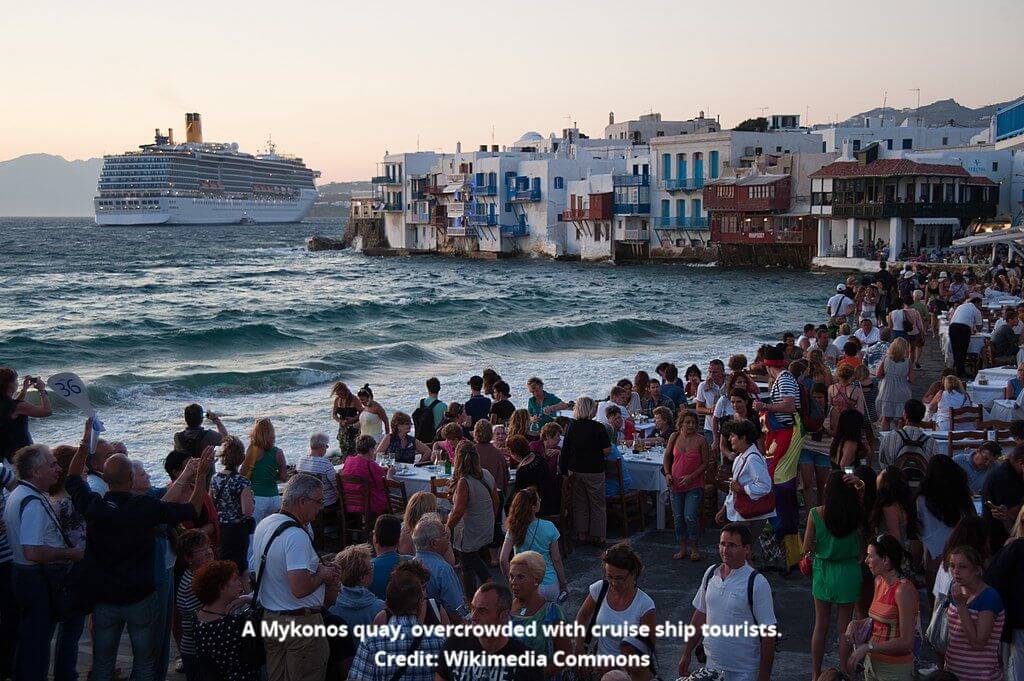This was the summer when much of Europe said to the ever-increasing flow of tourists, “Sorry, we are full.”
Of course, Europe isn’t full at all. It is just those places that we all want to go, that have been tugging at our imaginations since we began imagining, are hopelessly crowded — and some are brutally hot as well.
The most overcrowded getaways are in southern Europe: Nice, in the legendary South of France; Barcelona, Spain; Italian coastal towns, especially Venice; the best-known Greek islands such as Mykonos, Hydra and Santorini. Along the Croatian coast, Dubrovnik and Split are crowded.
What is ugly outside and delightful inside? Answer: a cruise ship.
The sight of those multitiered behemoths squeezing into a port that was designed for something a lot more gainly reminds me of someone struggling into clothes they have far outgrown. It can be done, but it isn’t pretty.
You can’t blame everything on cruise ships. They aren’t to blame for the summer traffic jams in Britain’s Lake District or around the Cotswolds. They aren’t the reason you can’t get into the great museums of Europe in summer, such as the Louvre in Paris or the Churchill War Rooms in London.
But cruise ships have become a particular problem for much of coastal Europe and aren’t the kind of tourism locals want.
The Greek tourism minister, Olga Kefalogianni, explained it to me when I interviewed her a few years ago. She said that the cruise ships dump a lot of people who don’t spend enough time (i.e., money) ashore. They disembark a veritable army who take tours and are back on board for supper. The ships tend to sail at night to avoid overnight docking fees, and the locals get very little economic gain from the thousands upon thousands who arrive every summer.
She told me Greece was trying to get more of the restocking contracts and to have more of the ships homeport in the country.
For tourists, in general, she said: Avoid the famous sights, such as the Acropolis in Athens, in summer and try to visit in the spring and fall.
She said for Greece, where tourism is especially important, it is a delicate matter, urging tourists to go to the less-visited northern areas of the country.
A couple of summers ago, I was in Santorini when five cruise ships arrived simultaneously. It was ugly. There is a cable railway to get up to the pretty town of Fira, and it meant waiting — and fuming and cursing all of the other cruise ships.
A friend said he had to ride down from the cliffside town on a donkey in order to make his ship’s departure.
There are questions about cruising. Many of them involve a kind of travel snobbery. Some seemingly well-traveled people reject cruising. “I wouldn’t want to be stuck with all those people. Never,” a friend told me.
A large cruise ship with nearly 6,000 passengers and a crew of about 2,000 is, well, just about the size of many of the largest hotels. New York’s Waldorf Astoria had 1,400 rooms from the time of its construction in 1931 until it was gutted and rebuilt recently — and the number of rooms was greatly reduced. The largest hotels in Las Vegas, the Mirage and the Venetian, are the size of the largest ships.
The problem isn’t with the number of your fellow cruisers, but with the destination ports: The cruise ships have worn out their welcome in some places, not others.
My wife and I were hostile to cruising until we did it. That was in the Mediterranean and the Black Sea in the early 1990s and we saw places — such as Yalta, Odessa and Constantia — that we maybe wouldn’t have seen otherwise.
So, we formed a pattern of using cruising for exploration rather than sightseeing. We went through the Panama Canal when it came back into the news because we wanted to see it and know what it was like. We went around Cape Horn, seeing one of the ends-of-the-earth places, where so many mariners have died, from the comfort of a luxury liner.
That is bucket list-stuff, and I want more of it.

 Follow
Follow
Leave a Reply